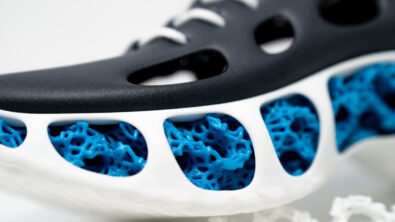Revolutionizing manufacturing with additive manufacturing materials

The potential for developing diverse and innovative additive manufacturing (AM) materials is limitless. In traditional manufacturing, the process for materials has been established and understood for decades, with standardized formulas for their creation. However, this reality does not exist in the additive world, leaving additive materials as an area ripe for innovation.
AM Materials – how are they used?

The choice of material for additive manufacturing is a result of many inputs. The purpose of the final manufactured part can determine the material used in its construction. Design requirements like weight, strength, thermal performance and cost targets define the range of materials that might be used during manufacturing.
For example, a design made from titanium might require specific strength parameters, whereas an aluminum part’s focus is cost constraints. Both materials are printable using additive techniques, but the choice of materials depends on the needs of the design and the business.
Furthermore, different additive technologies result in different structural characteristics. Parts created by a machine that uses a filament as the material delivery method will often have a different material structure than those using powder as the material delivery method even when the base materials are the same. Considerations like these must be understood and accounted for in the design and eventual manufacturing of any part.
Additive manufacturing base materials, digital materials
The list of usable materials for AM is expanding, utilizing various alloys. But the development process is not simple, thus requiring laborious research, time and investment. Major material suppliers are entering this sector, developing new printable materials with specific parameters in mind, including strength-to-weight ratios, thermal dissipation and electrical conductivity.
Most printer manufacturers condone the use of their hardware for a set of tested and approved materials. Customers who stray from the manufacturer guidelines risk voiding the warranty on their hardware. While the printer manufacturers continually look to expand the approved materials, this process is costly and laborious. This has led to new materials being introduced to the market slowly as each material must be certified by the user for its final performance in the field. Furthermore, it must also be verified by the hardware vendor for use in various machines.
One way around this problem is to use an approved base material. This involves building physical structures that mimic the desired behavior that may be present in other non-approved materials. For example, one might design an area of a part with a spring-type structure rather than changing it to a non-standard material that inherently has the desired energy return. These “digital materials” are quickly becoming a new dynamic in product design. The design freedom afforded by additive manufacturing has given designers the ability to modify the shape of a design to achieve performance goals digitally while using a single physical base material.
Also, additive manufacturing materials can be digitally altered to the raw material porosity and structure of a part or product. By adjusting machine parameters and design geometry, creative companies are pushing the envelope by finely controlling the deposition and melting of additive materials. This type of tight control requires a very high degree of machine and material knowledge to execute and is beyond the limits of most manufacturers presently.
AM Materials – research broadening the market
Research with AM materials is also pushing the ability of designers and manufacturers beyond previous limits. Some companies like Siemens are studying ways to allow users to input their desired material characteristics as part of the design and manufacturing process. Other companies are looking to simulate the blending of different powders or materials and their effect on final manufactured parts. These types of research and investment will broaden use cases for further adoption of this technology in an expanding marketplace.
One can imagine a future state where the designer sets the part parameters and weights those parameters as inputs to the design system. The system then considers the capabilities of the manufacturing platform and the capabilities of the materials available. It returns with a part recipe including geometry (including “digital materials”), base material mix and machine parameters. While we are probably decades from such a reality, you can see the beginnings of this thinking in today’s generative design systems.
AM Materials – revolutionizing manufacturing
At the present, the story of materials for additive manufacturing is mostly a story of potential. The list of materials available for additive manufacturing is growing, but not yet equal to those of other manufacturing methods. However, creative companies are getting around those limitations by designing “digital materials.” Other companies are diligently working on new materials and processes to expand the uses for additive manufacturing. We expect to see the market for printable materials continue to grow, and we are excited by the new design possibilities that expansion will enable.
Siemens Digital Industries Software provides the Xcelerator portfolio, a suite of software and services covering the end-to-end additive manufacturing process. This software includes simulating and 3D printing of parts and products with quality on an industrial scale, using innovative materials while implementing structural characteristics and saving time and money, thus accelerating the adoption rate of this technology.
About the author:
Ashley Eckhoff has a background in engineering and has been with Siemens for over 20 years in various capacities. He has spent the past few years deep-diving into additive manufacturing in both product design and marketing roles.

